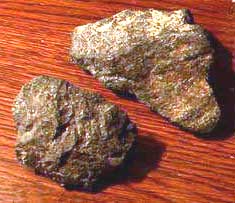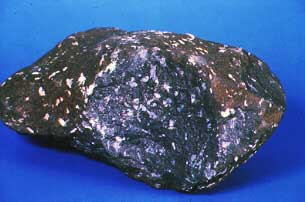cumberlandite
Cumberlandite is the U.S. state of Rhode Island's state rock. It is only found in large concentrations on a four-acre lot* in Blackstone Valley, Cumberland, and in traces scattered throughout the Narragansett Bay watershed. Due to its high amounts of iron, it is slightly magnetic and has been sold as 'meteorites'.
One researcher has classified it into three diferent types:
(1) Monotonuous Cumberlandite - no white plagioclase crystals
(2) Ornament Cumberlandite - varying white plagioclase crystals
(3) Tenuous Cumberlandite - greenish plagioclase crystals

weathered cumberlandite
The unique mineral was formed over 1.5 billion years ago by volcanic activity. The rocks were discovered by settlers hundreds of years ago, and were initially deemed valuable for the manufacture of cannons and farm tools in the 18th and 19th centuries. The mineral also contains a relatively high level of titanium, also valuable for the manufacture of tools. Colonists tried to make cannons from the mineral during the Revolutionary War, but the cannons cracked because of the weakness of the iron. Cumberlandite weathers to a brown-ish black with white crystals. This is strikingly different from the weathered look of other rocks in Rhode Island's glacial deposits. It is also much denser than the granites and metamorphic rocks that are common in these deposits. The rock is common in glacial deposits just south of its source location, and can be found in deposits all the way to the southern shore of Narragansett. This combination of coming from only one location, being obviously different from other rocks, and being easily identified by members of the public led to its being selected as the Rhode Island state rock.
Wikipedia
* Cumberland, Rhode Island 02864, Iron Rock Hill, near the intersection of West Wrentham Road and Elder Ballou Meetinghouse Road about three miles east of Woonsocket, R.I., four miles SW of the NE corner of R.I. and one mile from the Massachusetts state line.

Cumberlandite's recognizable white crystals
One researcher has classified it into three diferent types:
(1) Monotonuous Cumberlandite - no white plagioclase crystals
(2) Ornament Cumberlandite - varying white plagioclase crystals
(3) Tenuous Cumberlandite - greenish plagioclase crystals

weathered cumberlandite
The unique mineral was formed over 1.5 billion years ago by volcanic activity. The rocks were discovered by settlers hundreds of years ago, and were initially deemed valuable for the manufacture of cannons and farm tools in the 18th and 19th centuries. The mineral also contains a relatively high level of titanium, also valuable for the manufacture of tools. Colonists tried to make cannons from the mineral during the Revolutionary War, but the cannons cracked because of the weakness of the iron. Cumberlandite weathers to a brown-ish black with white crystals. This is strikingly different from the weathered look of other rocks in Rhode Island's glacial deposits. It is also much denser than the granites and metamorphic rocks that are common in these deposits. The rock is common in glacial deposits just south of its source location, and can be found in deposits all the way to the southern shore of Narragansett. This combination of coming from only one location, being obviously different from other rocks, and being easily identified by members of the public led to its being selected as the Rhode Island state rock.
Wikipedia
* Cumberland, Rhode Island 02864, Iron Rock Hill, near the intersection of West Wrentham Road and Elder Ballou Meetinghouse Road about three miles east of Woonsocket, R.I., four miles SW of the NE corner of R.I. and one mile from the Massachusetts state line.

Cumberlandite's recognizable white crystals


